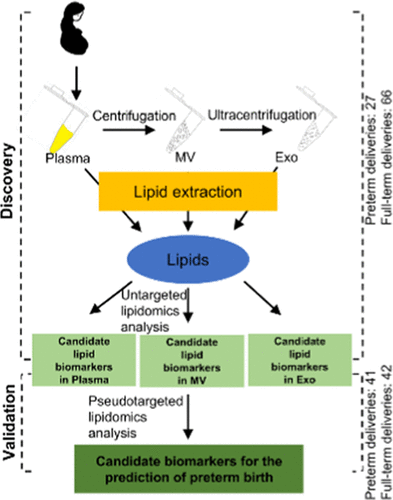当前位置:
X-MOL 学术
›
J. Proteome Res.
›
论文详情
Our official English website, www.x-mol.net, welcomes your
feedback! (Note: you will need to create a separate account there.)
Lipidomic Biomarkers of Extracellular Vesicles for the Prediction of Preterm Birth in the Early Second Trimester.
Journal of Proteome Research ( IF 3.8 ) Pub Date : 2020-09-09 , DOI: 10.1021/acs.jproteome.0c00525 Qianqian Zhao 1 , Zhen Ma 1 , Xinran Wang 2, 3 , Minling Liang 2, 3 , Wenjing Wang 2, 4 , Fengxia Su 2, 4 , Huanming Yang 2, 5 , Ya Gao 2, 4 , Yan Ren 2, 3
Journal of Proteome Research ( IF 3.8 ) Pub Date : 2020-09-09 , DOI: 10.1021/acs.jproteome.0c00525 Qianqian Zhao 1 , Zhen Ma 1 , Xinran Wang 2, 3 , Minling Liang 2, 3 , Wenjing Wang 2, 4 , Fengxia Su 2, 4 , Huanming Yang 2, 5 , Ya Gao 2, 4 , Yan Ren 2, 3
Affiliation

|
Preterm birth is the leading cause of infant death worldwide and results in a high societal economic burden associated with newborn care. Recent studies have shown that extracellular vesicles (EVs) play an important role in fetal development during pregnancy. Lipids in EVs related to preterm birth remain undefined. Here, we fully investigated differences in lipids in plasma, microvesicles (MVs), and exosomes (Exos) between 27 preterm and 66 full-term pregnant women in the early second trimester (12–24 weeks) using an untargeted lipidomics approach. Independent of other characteristics of samples, we detected 97, 58, and 10 differential features (retention time (RT) and m/z) with identification in plasma, MVs, and Exos, respectively. A panel of five lipids from MVs has an area under the receiver operating characteristic curve (AUC) of 0.87 for the prediction of preterm birth. One lipid of the panel (PS (34:0)) was validated in an additional 83 plasma samples (41 preterm and 42 full-term deliveries) by the pseudotargeted lipidomics method (AUC = 0.71). Our results provide useful information about the early prediction of preterm birth, as well as a better understanding of the underlying mechanisms and intervention of preterm birth. The MS data have been deposited in the CNSA (https://db.cngb.org/cnsa/) of CNGBdb with accession code CNP0001076.
中文翻译:

细胞外囊泡的脂质学生物标记物,用于预测早孕期的早产。
早产是全球婴儿死亡的主要原因,并导致与新生儿护理相关的高社会经济负担。最近的研究表明,胞外囊泡(EVs)在怀孕期间的胎儿发育中起着重要作用。与早产有关的电动汽车中的脂质仍不确定。在这里,我们使用非靶向脂质组学方法,全面调查了妊娠中期(12-24周)的27名早产孕妇和66名足月孕妇之间血浆,微囊泡(exossomes)和血浆脂质,微囊泡(exossomes)的差异。独立于样品的其他特征,我们检测到97、58和10个差异特征(保留时间(RT)和m / z)分别在血浆,MV和Exos中进行鉴定。来自MV的五种脂质的组在0.87的受体工作特征曲线(AUC)下的面积用于预测早产。通过伪靶向脂质组学方法(AUC = 0.71)在另外的83个血浆样品(41个早产和42个足月分娩)中验证了组中的一种脂质(PS(34:0))。我们的结果提供了有关早产的早期预测的有用信息,以及对早产的基本机制和干预措施的更好理解。MS数据已保存在CNGBdb的CNSA(https://db.cngb.org/cnsa/)中,登录号为CNP0001076。
更新日期:2020-10-02
中文翻译:

细胞外囊泡的脂质学生物标记物,用于预测早孕期的早产。
早产是全球婴儿死亡的主要原因,并导致与新生儿护理相关的高社会经济负担。最近的研究表明,胞外囊泡(EVs)在怀孕期间的胎儿发育中起着重要作用。与早产有关的电动汽车中的脂质仍不确定。在这里,我们使用非靶向脂质组学方法,全面调查了妊娠中期(12-24周)的27名早产孕妇和66名足月孕妇之间血浆,微囊泡(exossomes)和血浆脂质,微囊泡(exossomes)的差异。独立于样品的其他特征,我们检测到97、58和10个差异特征(保留时间(RT)和m / z)分别在血浆,MV和Exos中进行鉴定。来自MV的五种脂质的组在0.87的受体工作特征曲线(AUC)下的面积用于预测早产。通过伪靶向脂质组学方法(AUC = 0.71)在另外的83个血浆样品(41个早产和42个足月分娩)中验证了组中的一种脂质(PS(34:0))。我们的结果提供了有关早产的早期预测的有用信息,以及对早产的基本机制和干预措施的更好理解。MS数据已保存在CNGBdb的CNSA(https://db.cngb.org/cnsa/)中,登录号为CNP0001076。











































 京公网安备 11010802027423号
京公网安备 11010802027423号